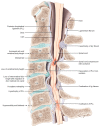Degenerative Cervical Myelopathy: A Brief Review of Past Perspectives, Present Developments, and Future Directions
- PMID: 32079075
- PMCID: PMC7073521
- DOI: 10.3390/jcm9020535
Degenerative Cervical Myelopathy: A Brief Review of Past Perspectives, Present Developments, and Future Directions
Abstract
Degenerative cervical myelopathy (DCM) is the most common cause of spinal cord injury in developed countries; its prevalence is increasing due to the ageing of the population. DCM causes neurological dysfunction and is a significant cause of disability in the elderly. It has important negative impacts on the quality of life of those affected, as well as on their caregivers. DCM is triggered by a variety of degenerative changes in the neck, which affect one or more anatomical structures, including intervertebral discs, vertebrae, and spinal canal ligaments. These changes can also lead to structural abnormalities, leading to alterations in alignment, mobility, and stability. The principle unifying problem in this disease, regardless of the types of changes present, is injury to the spinal cord due to compression by static and/or dynamic forces. This review is partitioned into three segments that focus on key elements of the past, the present, and the future in the field, which serve to introduce the focus issue on "Degenerative Cervical Myelopathy and the Aging Spine". Emerging from this review is that tremendous progress has been made in the field, particularly in recent years, and that there are exciting possibilities for further advancements of patient care.
Keywords: cervical spondylotic myelopathy; compressive myelopathy; focus issue; update.
Conflict of interest statement
Aria Nouri declare no conflict of interest. Enrico Tessitore declares receiving training fees from Spineart, NuVasive and DePuy Synthes. No funds were received for supporting this work.
Figures

References
Publication types
LinkOut - more resources
Full Text Sources
Miscellaneous

